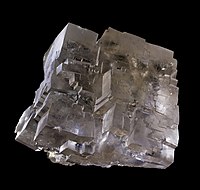
Photo from wikipedia
Five negatively charged organic compounds with different structures, sodium methane sulfonate (MS), sodium benzene sulfonate (BS), sodium 6-hydroxynaphthalene-2-sulfonate (NSS), sodium dodecyl sulfate (SDS), and sodium dodecyl benzene sulfonate (SDBS), were… Click to show full abstract
Five negatively charged organic compounds with different structures, sodium methane sulfonate (MS), sodium benzene sulfonate (BS), sodium 6-hydroxynaphthalene-2-sulfonate (NSS), sodium dodecyl sulfate (SDS), and sodium dodecyl benzene sulfonate (SDBS), were used to examine the fouling of an anion exchange membrane (AEM) in electrodialysis (ED), to explore the effect of molecular characteristics on the fouling behavior on the AEM and changes in the surface and electrochemical properties of the AEM. Results indicated that the fouling degree of the AEM by the different organics followed the order: SDBS > SDS > NSS > BS > MS. SDBS and SDS formed a dense fouling layer on the surface of the AEM, which was the main factor in the much more severe membrane fouling, and completely restricted the transmembrane ion migration. The other three organics caused fouling of the AEM by adsorption on the surface and /or accumulation in the interlayer of the AEM, and exhibited almost no influence on the transmembrane ion migration. It was also concluded that the organics with benzene rings caused more severe fouling of the AEM due to the stronger affinity interaction and steric effect between the organics and the AEM compared with organics with aliphatic chains.
Journal Title: Journal of environmental sciences
Year Published: 2019
Link to full text (if available)
Share on Social Media: Sign Up to like & get
recommendations!